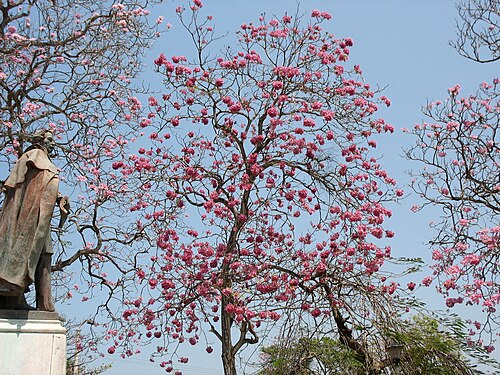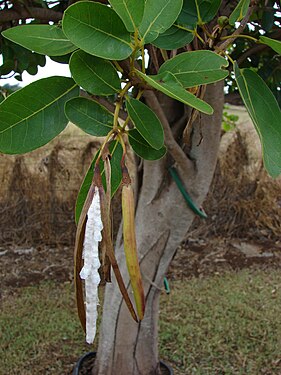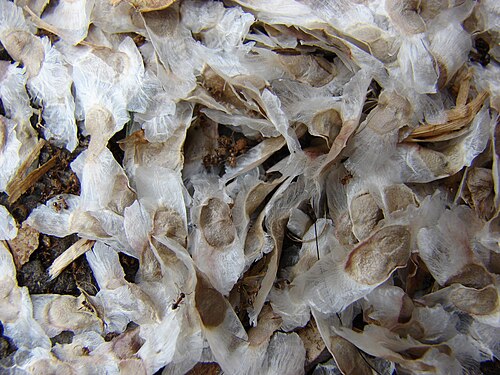Difference between revisions of "Tabebuia rosea"
| Line 1: | Line 1: | ||
{{SPlantbox | {{SPlantbox | ||
| − | |genus=Tabebuia | + | |familia=Bignoniaceae |
| + | |genus=Tabebuia | ||
|species=rosea | |species=rosea | ||
| + | |common_name=Roble de Sabana | ||
|habit=tree | |habit=tree | ||
|Min ht box=90 | |Min ht box=90 | ||
| Line 7: | Line 9: | ||
|Min wd box=30 | |Min wd box=30 | ||
|Min wd metric=ft | |Min wd metric=ft | ||
| + | |lifespan=perennial | ||
|exposure=sun | |exposure=sun | ||
| + | |features=flowers | ||
|flower_season=early spring, mid spring, late spring | |flower_season=early spring, mid spring, late spring | ||
|flowers=red, pink, white | |flowers=red, pink, white | ||
| Line 13: | Line 17: | ||
|min_zone=11 | |min_zone=11 | ||
|max_zone=12 | |max_zone=12 | ||
| − | + | |image=Starr 061206-1951 Tabebuia rosea.jpg | |
| − | |image= | ||
|image_width=240 | |image_width=240 | ||
}} | }} | ||
| − | + | '''''Tabebuia rosea''''' is a neotropical tree that grows up to {{Convert|30|m|in|0|abbr=on}} and can reach a [[diameter at breast height]] of up to {{Convert|100|cm|ft|0|abbr=on}}. The name '''Roble de Sabana''' is widely used in [[Costa Rica]] meaning "savannah oak" in [[Spanish language|Spanish]], probably because it often remains in heavily deforested areas, where people prize its intense flowering periods and because of the resemblance of its wood with the oak wood<ref>Hernan Rodriguez Navas. 2007. La Utilidad de las Plantas Medicinales en Costa Rica. EUNA, Heredia, Costa Rica. 213pp.</ref> The name '''Maquilishuat''' is almost entirely used by the inhabitants of El Salvador to designate the Tabeuia rosea; it's also their [[national tree]]. | |
| − | | name | + | |
| − | + | This species is distributed from southern [[Mexico]], to [[Venezuela]] and [[Ecuador]]. It has been found growing from [[sealevel]] to {{Convert|1200|m|ft|0|abbr=on}}, in [[temperature]]s ranging from 20°C to 30°C on average, with annual [[rainfall]] above 500 mm, and on soils with very variable [[pH]]. | |
| − | | | + | |
| − | | | + | The tree crown is wide, with irregular, stratified [[Ramification (botany)|ramification]] and only few thick branches. The bark can be gray to brown, in varying darkness and may be vertically fissured. [[Leaf|Leaves]] are [[Compound (botany)|compound]], [[digitate]] and [[deciduous]]. Each leaf has five [[leaflet]]s of variable size, the middle one being the largest. Flowering occurs mainly in January and February, and is generally associated with dry periods; although flowering has also been observed in August, September, April and May. Flowers are large, in various tones of pink to purple, and appear while the tree has none, or very few, leaves. [[Pollination]] occurs probably by insects, although the flowers are visited by many birds such as [[tanager]]s, [[hummingbird]]s and [[New World oriole|orioles]]. The long and slender fruit capsules can measure up to {{Convert|35|cm|in|0|abbr=on}} and appear from February through April. After the drying fruit [[Dehiscence (botany)|dehisces]], the anemochorous, [[hyaline]]-[[membrane]]-[[Seed dispersal#Wind|winged]] seeds are released. There are an average of 45,000 seeds per [[kg]] with up to 13% water content. [[Germination]] of seeds is extremely easy and efficient, reaching almost 100%. |
| − | | | + | |
| − | | | + | This tree is often seen in [[Neotropic]]al cities, where it is often planted in parks and gardens. In the rainy season it offers great shade and, in the dry season, abundant flowers are present on the defoliated trees. |
| − | + | ||
| − | |||
| − | | | ||
| − | | | ||
| − | |||
| − | |||
| − | |||
| − | | | ||
| − | | | ||
| − | | | ||
| − | |||
| − | |||
| − | |||
| − | |||
| − | |||
| − | |||
| − | |||
| − | |||
| − | |||
| − | |||
| − | |||
| − | |||
| − | |||
{{Inc| | {{Inc| | ||
| − | |||
Tabebuia rosea, DC. (Tecoma rosea, Bertol.). Evergreen tree: lvs. digitate; lfts. 5, rarely 3, long-stalked, ovate to oblong, acuminate, entire: fls. in many-fld. terminal panicles; corolla funnelform-campanulate, with short tube and large spreading lobes, rosy pink; calyx campanulate, obscurely 2-lobed, almost truncate. Guatemala. | Tabebuia rosea, DC. (Tecoma rosea, Bertol.). Evergreen tree: lvs. digitate; lfts. 5, rarely 3, long-stalked, ovate to oblong, acuminate, entire: fls. in many-fld. terminal panicles; corolla funnelform-campanulate, with short tube and large spreading lobes, rosy pink; calyx campanulate, obscurely 2-lobed, almost truncate. Guatemala. | ||
{{SCH}} | {{SCH}} | ||
| Line 68: | Line 48: | ||
{{photo-sources}}<!-- remove this line if there are already 3 or more photos in the gallery --> | {{photo-sources}}<!-- remove this line if there are already 3 or more photos in the gallery --> | ||
| − | <gallery> | + | <gallery perrow=5> |
| − | + | File:Roblemorado.jpg | |
| − | + | File:Starr 060928-0498 Tabebuia rosea.jpg | |
| − | + | File:Starr 070810-8010 Tabebuia rosea.jpg | |
| + | File:Tabebuia rosea 0006.jpg | ||
| + | File:Starr 060928-0493 Tabebuia rosea.jpg | ||
| + | File:Starr 060928-0495 Tabebuia rosea.jpg | ||
| + | File:Starr 060928-0496 Tabebuia rosea.jpg | ||
| + | File:Starr 060928-0519 Tabebuia rosea.jpg | ||
</gallery> | </gallery> | ||
| Line 83: | Line 68: | ||
*{{wplink}} | *{{wplink}} | ||
| − | + | __NOTOC__ | |
| − | |||
| − | |||
| − | |||
Revision as of 16:58, 14 April 2010
| Habit | tree
| |
|---|---|---|
| Lifespan: | ⌛ | perennial |
| Bloom: | ❀ | early spring, mid spring, late spring |
| Exposure: | ☼ | sun |
|---|---|---|
| Features: | ✓ | flowers |
| USDA Zones: | 11 to 12 | |
| Flower features: | ❀ | red, pink, white |
|
Tabebuia > |
rosea > |
Tabebuia rosea is a neotropical tree that grows up to 30 m in 0 and can reach a diameter at breast height of up to 100 cm ft 0. The name Roble de Sabana is widely used in Costa Rica meaning "savannah oak" in Spanish, probably because it often remains in heavily deforested areas, where people prize its intense flowering periods and because of the resemblance of its wood with the oak wood[1] The name Maquilishuat is almost entirely used by the inhabitants of El Salvador to designate the Tabeuia rosea; it's also their national tree.
This species is distributed from southern Mexico, to Venezuela and Ecuador. It has been found growing from sealevel to 1200 m ft 0, in temperatures ranging from 20°C to 30°C on average, with annual rainfall above 500 mm, and on soils with very variable pH.
The tree crown is wide, with irregular, stratified ramification and only few thick branches. The bark can be gray to brown, in varying darkness and may be vertically fissured. Leaves are compound, digitate and deciduous. Each leaf has five leaflets of variable size, the middle one being the largest. Flowering occurs mainly in January and February, and is generally associated with dry periods; although flowering has also been observed in August, September, April and May. Flowers are large, in various tones of pink to purple, and appear while the tree has none, or very few, leaves. Pollination occurs probably by insects, although the flowers are visited by many birds such as tanagers, hummingbirds and orioles. The long and slender fruit capsules can measure up to 35 cm in 0 and appear from February through April. After the drying fruit dehisces, the anemochorous, hyaline-membrane-winged seeds are released. There are an average of 45,000 seeds per kg with up to 13% water content. Germination of seeds is extremely easy and efficient, reaching almost 100%.
This tree is often seen in Neotropical cities, where it is often planted in parks and gardens. In the rainy season it offers great shade and, in the dry season, abundant flowers are present on the defoliated trees.
Read about Tabebuia rosea in the Standard Cyclopedia of Horticulture
|
|---|
|
Tabebuia rosea, DC. (Tecoma rosea, Bertol.). Evergreen tree: lvs. digitate; lfts. 5, rarely 3, long-stalked, ovate to oblong, acuminate, entire: fls. in many-fld. terminal panicles; corolla funnelform-campanulate, with short tube and large spreading lobes, rosy pink; calyx campanulate, obscurely 2-lobed, almost truncate. Guatemala. CH
|
Cultivation
- Do you have cultivation info on this plant? Edit this section!
Propagation
- Do you have propagation info on this plant? Edit this section!
Pests and diseases
- Do you have pest and disease info on this plant? Edit this section!
Species
Gallery
If you have a photo of this plant, please upload it! Plus, there may be other photos available for you to add.
References
- Standard Cyclopedia of Horticulture, by L. H. Bailey, MacMillan Co., 1963
External links
- w:Tabebuia rosea. Some of the material on this page may be from Wikipedia, under the Creative Commons license.
- Tabebuia rosea QR Code (Size 50, 100, 200, 500)
- ↑ Hernan Rodriguez Navas. 2007. La Utilidad de las Plantas Medicinales en Costa Rica. EUNA, Heredia, Costa Rica. 213pp.








